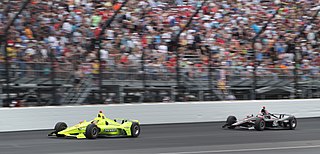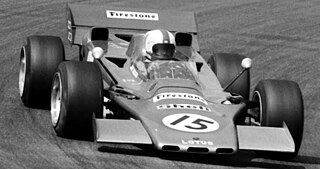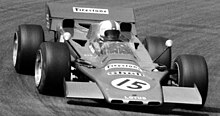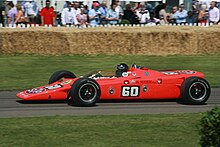
Anthony Joseph Foyt Jr. is an American retired auto racing driver who has raced in numerous genres of motorsports. His open wheel racing includes United States Automobile Club Champ cars, sprint cars, and midget cars. He raced stock cars in NASCAR and USAC. He won several major sports car racing events. He holds the USAC career wins record with 159 victories, and the American championship racing career wins record with 67.

Rick Ravon Mears is a retired American race car driver. He is one of four men to win the Indianapolis 500 four times and is the current record-holder for pole positions in the race with six. Mears is also a three-time Indycar series/World Series champion.

The Pratt & Whitney Canada PT6 is a turboprop aircraft engine produced by Pratt & Whitney Canada. Its design was started in 1958, it first ran in February 1960, first flew on 30 May 1961, entered service in 1964 and has been continuously updated since. It consists of two basic sections: a gas generator with accessory gearbox and a free power turbine with reduction gearbox, and is often seemingly mounted backwards in an aircraft in so far as the intake is at the rear and the exhaust at the front. Many variants of the PT6 have been produced, not only as turboprops but also as turboshaft engines for helicopters, land vehicles, hovercraft, and boats; as auxiliary power units; and for industrial uses. By November 2015, 51,000 had been produced, had logged 400 million flight hours from 1963 to 2016. It is known for its reliability with an in-flight shutdown rate of 1 per 651,126 hours in 2016. The PT6A covers the power range between 580 and 1,940 shp while the PT6B/C are turboshaft variants for helicopters.
Michael Henderson Spence was a British racing driver from England. He participated in 37 Formula One World Championship Grands Prix, debuting on 8 September 1963. He achieved one podium, and scored a total of 27 championship points. He also participated in numerous non-Championship Formula One races, as well as sports car racing.

American open-wheel car racing, also known as Indy car racing, is a category of professional automobile racing in the United States. As of 2022, the top-level American open-wheel racing championship is sanctioned by IndyCar.

Rufus Parnell Jones is an American former professional racing driver and racing team owner. He is notable for his accomplishments while competing in the Indianapolis 500 and the Baja 1000 desert race. In 1962, he became the first driver to qualify over 150 mph. He won the race in 1963, then famously broke down while leading the 1967 race with three laps to go in a turbine car. During his career as an owner, he won the Indy 500 in 1970–1971 with driver Al Unser, Sr.

David Walker is an Australian former racing driver who drove for Lotus in the 1971 and 1972 Formula One World Championships.
This article discusses the year-by-year history of the Indianapolis 500 race.

Anthony "Andy" Granatelli was an American businessman, most prominent as the CEO of STP as well as a major figure in automobile racing events.

The 52nd International 500 Mile Sweepstakes was held at the Indianapolis Motor Speedway in Speedway, Indiana on Thursday May 30, 1968. For the second year in a row, one of Andy Granatelli's STP Turbine-powered machines was leading late in the race, but once again, it failed within sight of victory.

The 53rd International 500 Mile Sweepstakes was an auto race held at the Indianapolis Motor Speedway in Speedway, Indiana on Friday, May 30, 1969. It was the third round of the 1969 USAC Championship Car season. Polesitter A. J. Foyt led the race in the early stages, looking to become the first four-time winner of the 500. Near the halfway point, however, a lengthy pit stop to repair a broken manifold put him many laps down. Despite a hard-charging run towards the end, he wound up managing only an eighth-place finish, 19 laps down. Lloyd Ruby, a driver with a hard-luck reputation at the Speedway, was leading the race just after the midpoint. During a pit stop, he pulled away with the fueling hose still attached, ripped a hole in the fuel tank, and was out of the race. The incident put Mario Andretti in the lead for rest of the way.

The 51st International 500 Mile Sweepstakes was held at the Indianapolis Motor Speedway in Speedway, Indiana, over two days, Tuesday May 30 and Wednesday May 31, 1967. The race was dominated by Parnelli Jones in the radically new, four-wheel drive STP-Paxton Turbocar gas turbine entered by prolific car owner Andy Granatelli. With three laps to go, however, Jones coasted to a stop when a $6 transmission bearing failed. A. J. Foyt assumed the lead, and weaved his way through a pileup on the final lap, to win his third Indy 500 victory.

The 78th Indianapolis 500 was held at the Indianapolis Motor Speedway in Speedway, Indiana on Sunday, May 29, 1994. The race was sanctioned by United States Auto Club (USAC), and was included as race number 4 of 16 of the 1994 PPG IndyCar World Series. For the second year in a row, weather was nary a factor during the month. Only one practice day was lost to rain, and pole day was only partially halted due to scattered showers. Warm, sunny skies greeted race day.

Joe Leonard was an American professional motorcycle racer and racecar driver.

The 1993 PPG Indy Car World Series season was the 15th national championship season of American open wheel racing sanctioned by CART under the name "IndyCar". The season consisted of 16 races. Nigel Mansell was the national champion as well as the Rookie of the Year. The 1993 Indianapolis 500 was sanctioned by USAC, but counted towards the CART points championship. Emerson Fittipaldi won the Indy 500, his second career victory in that event.

The 1989 CART PPG Indy Car World Series season was the 11th national championship season of American open wheel racing sanctioned by CART. The season consisted of 15 races, and one non-points exhibition event. Emerson Fittipaldi was the national champion, and the rookie of the year was Bernard Jourdain. Fittipaldi became the second driver after Mario Andretti to win the Formula One World Championship and the CART championship.
Four-wheel drive (4WD) has only been tried a handful of times in Formula One. In the World Championship era since 1950, only eight such cars are known to have been built.

The STP-Paxton Turbocar was an American racing car, designed by Ken Wallis as the STP entry in the Indianapolis 500. Parnelli Jones drove it in the 1967 event. After leading for much of the race, a transmission failure with only eight miles left ended the run. It crashed during qualification for the 1968 race; the damage was not fixed and the car ended its career.
The Lotus 64 was a four-wheel drive racing car built by Lotus for the 1969 Indianapolis 500.

Indianapolis 500 Evolution is a racing game, developed by British studio Brain in a Jar Ltd, based on the Indianapolis 500 and American Championship car racing from 1961 to 1971. It is similar to Destineer's 2007 game Indianapolis 500 Legends. In the game, players take on the roles of various famous racers from that time period with 21 missions, photos, and movies, as well as competing on courses such as the Indianapolis Motor Speedway, as well as the Milwaukee Mile, Trenton, Riverside, Hanford and Langhorne Speedway. Honey Creek, the name for inner road course of the Milwaukee Mile, is also included, and is still used for various club racing events in the present day.


















